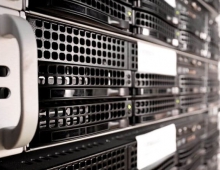
IBM makes data storage breakthrough
Researchers at IBM Corp. announced Tuesday the development of an ultra-dense storage technology that resembles the old computer punch cards - except that the latest version shrinks the perforations to a molecular scale...
The technology, developed under the code name ``millipede,'' was conceived by two scientists at IBM's Zurich research labs, who discussed the idea over beer after the company's weekly soccer games, said Peter Vettiger, the storage project's leader and one of those who conceived it.
The millipede lab prototypes can store as much as 20 times the data of the magnetic storage media used in today's computers, cramming as much as 25 million printed textbook pages of data on a surface the size of a postage stamp, the company said.
If IBM decides to manufacture millipede-based storage cards - it has no current plans to do so - the storage could begin replacing the current silicon-based flash memory cards in handheld computers and mobile phones by the end of 2005, Vettiger predicted.
``We see these devices in the mobile arena, in the handheld arena,'' Vettiger said. ``There is strong desire for an increase in storage capacity, beyond what flash memory can store. There is a requirement for low power, for small size and for low cost.''
IBM said the millipede devices can store one terabit, or a trillion pieces, of data per square inch. The data are stored in tiny sheets of plastic polymer film as tiny indentations just 10 nanometers, or millionths of a millimeter, in diameter.
Unlike punch cards, the new devices are re-writeable, meaning they can be erased and refilled over and over. Vettiger said IBM's tests have erased and refilled them hundreds of thousands of times.
Although described as a relative to the primitive punch card, Vettiger said the new memory technology is closer in design to the atomic force microscope, invented in 1986 by millipede co-designer Gerd Binnig, the Nobel prize winning co-inventor of the scanning-tunneling microscope.
Vettiger said the storage technology doesn't appear beset by the data density limits of flash memory chips, and could cram 10 to 15 gigabytes of data into a tiny format that would fit in a multifunctional wristwatch.
The millipede lab prototypes can store as much as 20 times the data of the magnetic storage media used in today's computers, cramming as much as 25 million printed textbook pages of data on a surface the size of a postage stamp, the company said.
If IBM decides to manufacture millipede-based storage cards - it has no current plans to do so - the storage could begin replacing the current silicon-based flash memory cards in handheld computers and mobile phones by the end of 2005, Vettiger predicted.
``We see these devices in the mobile arena, in the handheld arena,'' Vettiger said. ``There is strong desire for an increase in storage capacity, beyond what flash memory can store. There is a requirement for low power, for small size and for low cost.''
IBM said the millipede devices can store one terabit, or a trillion pieces, of data per square inch. The data are stored in tiny sheets of plastic polymer film as tiny indentations just 10 nanometers, or millionths of a millimeter, in diameter.
Unlike punch cards, the new devices are re-writeable, meaning they can be erased and refilled over and over. Vettiger said IBM's tests have erased and refilled them hundreds of thousands of times.
Although described as a relative to the primitive punch card, Vettiger said the new memory technology is closer in design to the atomic force microscope, invented in 1986 by millipede co-designer Gerd Binnig, the Nobel prize winning co-inventor of the scanning-tunneling microscope.
Vettiger said the storage technology doesn't appear beset by the data density limits of flash memory chips, and could cram 10 to 15 gigabytes of data into a tiny format that would fit in a multifunctional wristwatch.




















